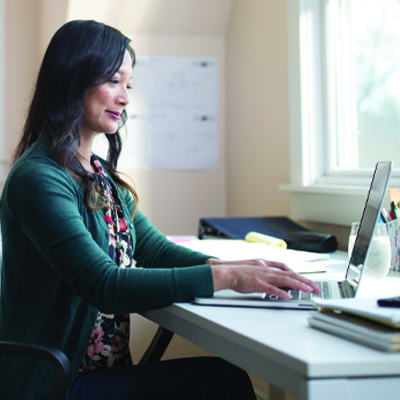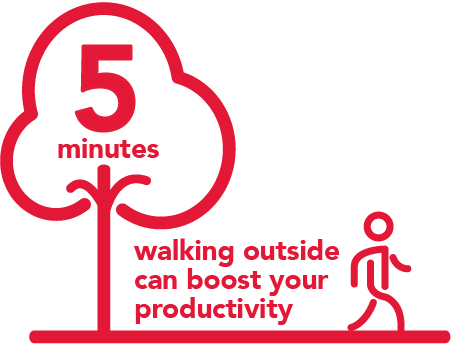
Published May 2020
With social distancing limiting our ability to connect and physically interact, daily screen time has seen a jump. And even before the COVID-19 global pandemic, there were concerns about what screen time is doing to our health. But screens are not inherently bad. Now, for many of us, they’re our window into the world—friends, family, fitness, and even foodspiration. But how can we make sure we have a healthy relationship with them? Here are some things to consider, from screen time strategies to surprising statistics.
The kids (and you) will be alright
Both adults and children are experiencing an increase in screen time, but experts are saying it’s going to be ok. In fact, there’s actually very little evidence directly connecting screen time to harm in kids. The bigger problem lies in screens replacing positive activities like exercise, socializing, and sleep. Here are three simple things to keep in mind.
 One media-free meal per day. Try to have at least one meal per day without screens. Screen time, and even background television during meals, have been linked to eating junk food and increased weight in children, as food ads for low-nutrition options can influence what preschoolers want to eat. Conversations during mealtime can help to shape a child’s social-emotional health and ease stress for the whole family.
One media-free meal per day. Try to have at least one meal per day without screens. Screen time, and even background television during meals, have been linked to eating junk food and increased weight in children, as food ads for low-nutrition options can influence what preschoolers want to eat. Conversations during mealtime can help to shape a child’s social-emotional health and ease stress for the whole family.
 Two screen-free hours before bed. Setting screens aside for two hours before bedtime makes it easier to fall asleep and wake up on time. The “blue light” from TVs and other screens disrupt the natural sleep cycle. For younger children, it also helps to save the screens for after naptime. For older kids, device alerts can be an issue as well. Try using a real alarm clock and keeping their phone out of the bedroom.
Two screen-free hours before bed. Setting screens aside for two hours before bedtime makes it easier to fall asleep and wake up on time. The “blue light” from TVs and other screens disrupt the natural sleep cycle. For younger children, it also helps to save the screens for after naptime. For older kids, device alerts can be an issue as well. Try using a real alarm clock and keeping their phone out of the bedroom.
 Three ways to measure screen use. The amount of time spent using a screen is just one of three ways to measure the health of technology use. The quality of the content and being there to help your child process what’s on screen are two important factors that can help create meaningful interactions.
Three ways to measure screen use. The amount of time spent using a screen is just one of three ways to measure the health of technology use. The quality of the content and being there to help your child process what’s on screen are two important factors that can help create meaningful interactions.
For more on the strategies above and specific guidelines on screen time for children of all ages, check out this Family Digital Wellness Guide from the Center on Media and Child Health.
“Parents right now will need to adjust to today’s reality. A different environment requires different choices.” — Dr. Michael Rich, Director, Center on Media and Child Health, Boston Children’s Hospital
Use the screen wisely
Screens have a way of turning our brains on autopilot. Whether you’re toggling between emails and notifications, or scrolling on social media, you can spend a lot of time getting nothing done. Here are some ways to make screen time more purposeful:
 Put your alerts on hold. Take notice of what kinds of alerts are luring you into mindless screen time and turn them off. The same guidelines go for adults as for children—limiting screen time after sunset, especially two hours before bed, can help you fall asleep easier.
Put your alerts on hold. Take notice of what kinds of alerts are luring you into mindless screen time and turn them off. The same guidelines go for adults as for children—limiting screen time after sunset, especially two hours before bed, can help you fall asleep easier.
Daily email detox. If possible, block your email for a period of time during the day so you can get work done without constant distraction.
Intermittent social fasting. Avoid social media during working hours to help you keep a better work-life balance. With increased focus, you’ll lower your chances of having to work late.
Leaning in is better than lying back
“Screen time” has been lumped into one big, guilt-inducing category. But we’re learning that there’s a difference in the mental effects of actively engaging with and passively absorbing what’s on the screen.
 Find your personal pump-ups. Many companies are stepping up with virtual opportunities for some self-care. Harvard Pilgrim is offering free weekly exercise classes, mindfulness training, and healthy webinars (open to everyone), and many fitness brands are offering free online or in-app classes, including family-friendly workouts.
Find your personal pump-ups. Many companies are stepping up with virtual opportunities for some self-care. Harvard Pilgrim is offering free weekly exercise classes, mindfulness training, and healthy webinars (open to everyone), and many fitness brands are offering free online or in-app classes, including family-friendly workouts.
 Set limits on scrolling. Social media has the ability to connect us across cultures, causes, and continents—but healthy connections aren’t made through passive scrolling. Set a limit to how long you’ll let yourself scroll, and use the rest of the time to call a family member or friend. If you depend on social media to help you stay connected, look for more active ways to harness it for good.
Set limits on scrolling. Social media has the ability to connect us across cultures, causes, and continents—but healthy connections aren’t made through passive scrolling. Set a limit to how long you’ll let yourself scroll, and use the rest of the time to call a family member or friend. If you depend on social media to help you stay connected, look for more active ways to harness it for good.
Step away from the screen
If you’re not used to having your office at home, it’s easy to get chained to your desk. But if you sit still for too long, your brain will follow suit. It helps to keep moving, both physically and mentally, and you might find that you can get more done when you get back.
 Walk to unlock productivity. Studies show that getting a quick hit of nature can boost performance, and just five minutes of walking outside can help improve your mood and self-esteem.
Walk to unlock productivity. Studies show that getting a quick hit of nature can boost performance, and just five minutes of walking outside can help improve your mood and self-esteem.
Seek out chats and check-ins. Without the usual office chatter, we miss out on necessary breaks from work. Try getting some real face time in with family members or roommates, or if you live alone, get on the phone for a quick catch-up.
Don’t lunch where you crunch. Eating in your workspace can cause you to eat more and think less. Before working from home, 67% of office workers were eating at their desks, but now—with the lines between work and life becoming increasingly blurred—it’s even more important to break that habit.
Screens have become more embedded in our daily lives than ever before. But learning how to work with the devices in your household is key. Limiting your and your family’s amount of screen time is only part of the equation. Focus on the quality of your screen time, ask yourself what kind of positive activities the screen might be replacing, and set up realistic rules for your household. But remember to go easy on yourself—we’re all just wading through uncharted waters.
To confirm eligibility for any programs or services mentioned in this article as it relates to your specific health plan, please reach out to your account executive or HR benefits team. You may also speak to our member services team at (888)-333-4742 or by sending a secure email. And for plan details and other member resources, log in to the member portal.